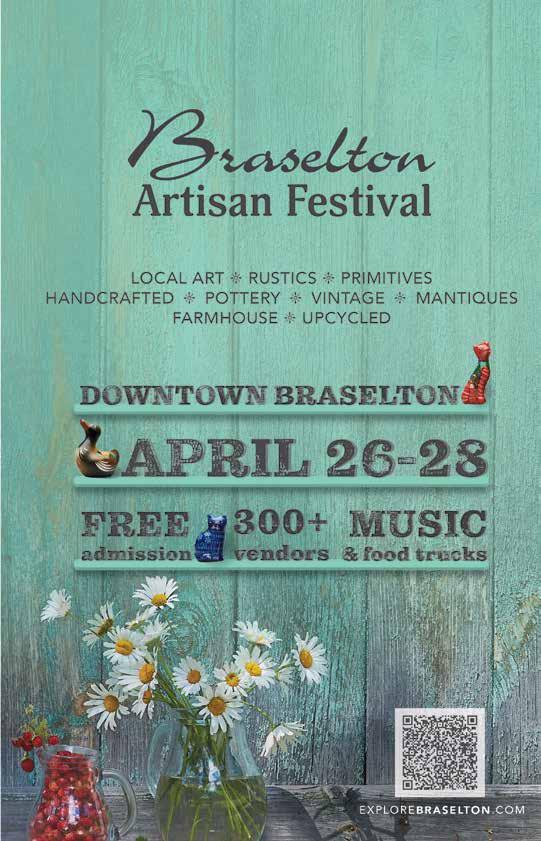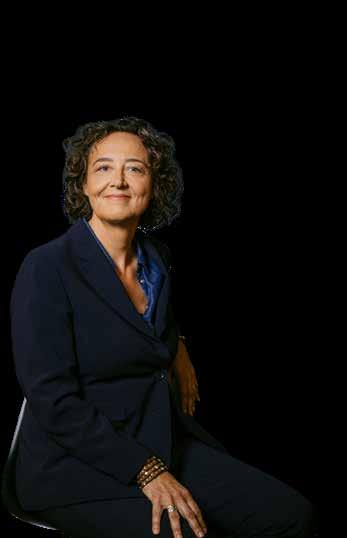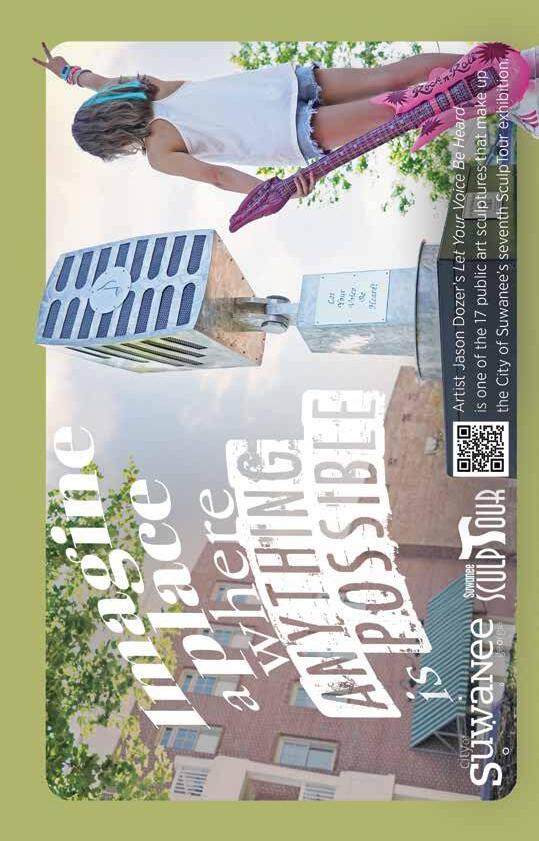ASO’s 80th Season Celebrates the Classical
By Holly Hanchey

ECCLES
ANDREW
Last month, the Atlanta Symphony Orchestra announced the 2024/25 season, which is the Orchestra’s 80th year of making music. Those who have seen the season will notice it has a decidedly Classical thread running through the programming.
While almost everything the ASO plays can be considered classical music, in this case, the Orchestra is playing a “Capital C” Classical season—a distinct era of music from approximately the 1730s through early 1820s, when composers like Mozart, Haydn, and Beethoven worked and flourished in and around Vienna. The piano became the instrument of choice, over the harpsichord, and the chamber music ensembles popular in the Baroque period gave way for the birth of the symphony.
It is a fitting theme for Music Director Nathalie Stutzmann’s third season on the podium in Symphony Hall. “With each year, the orchestra and I get to know one another more and more, and this season I am eager to dive into some of the cornerstones of the Classical period,” said Stutzmann. “Composers like Mozart, Haydn, and Beethoven are familiar to us but also essential foundations of our repertoire. I often say that these composers are doctors and medicine for the orchestra’s soul.”
The Classical theme runs through the entire season, incorporating choices from both Stutzmann and guest conductors. According to the ASO’s Vice President of Artistic Planning, Gaetan Le Divelec, “This is repertoire that emphasizes a holistic orchestra sound, and focuses on how the musicians play together, developing a uniquely expressive sound, developing ‘muscles’ of being a cohesive orchestra.”
One of the highlights of the new season is Stutzmann’s Beethoven Project, a series of concert weekends in which the Orchestra appears without guest artists, playing the masterful composer’s first eight symphonies, though they are not necessarily played in order. Beginning in January of 2025, Stutzmann has paired the symphonies so that audiences can fully understand and follow Beethoven’s journey as a composer.
This season I am eager to dive into some of the cornerstones of the Classical period,” said Stutzmann. “Composers like Mozart, Haydn, and Beethoven are familiar to us but also essential foundations of our repertoire.
encoreatlanta.com | 13



The Project begins in January when the Orchestra will play the First and Third Symphony; the first marking the beginning of his symphonic composition period, and the third the famous “Eroica” symphony, a more dramatic piece showing the composer’s developing style. The following weekend, Stutzmann conducts the Second Symphony, a lesser-known of the series, and the incredibly famous Fifth Symphony.
The Beethoven Project continues in February and March with a concert featuring Symphony Nos. 8 and 6, “Pastoral,” which is followed quickly with the final symphonies for this season—the Fourth and Seventh.
At the beginning of April, the Project turns from the symphonies to Beethoven’s Concerto for Violin, Cello, and Piano, commonly known as the Triple Concerto, featuring Concertmaster David Coucheron, Acting/Associate Principal Cello Daniel Laufer, and pianist Julie Coucheron.
The Beethoven Project would not be complete without an appearance from the world-renowned Atlanta Symphony Orchestra Chorus, and concludes its 2024/25 season run with the gigantic Missa solemnis, a piece that biographer Jan Swafford called “the greatest piece never heard.” It is fiendishly difficult for both orchestra and chorus, but in the hands of Stutzmann, the ASO, and Chorus, along with four acclaimed opera singers, it is sure to be a magnificent experience.
This Classical season isn’t just about Beethoven. The Orchestra will play three Haydn symphonies that have not been heard in Symphony Hall since Robert Shaw
aso.org | @AtlantaSymphony | facebook.com/AtlantaSymphony
| encore 14
was music director, including Symphony No. 104, “London,” conducted by Earl Lee who makes his ASO debut in October; Symphony No. 96 in November, conducted by Nicholas Carter; and Symphony No. 101, “The Clock,” conducted by Matthew Halls, who makes his debut in a program that also features the debut of the dazzling young cellist Sterling Elliott.
In addition to the composer’s symphonies, one of the best musicians in the world joins the ASO—acclaimed cellist Yo-Yo Ma—joins the ASO to play Haydn’s Cello Concerto No. 1 with guest conductor Eric Jacobsen, in a special one-night-only performance on December 5, 2024.
The ASO has not forgotten the third pillar of the Classical era, Mozart, whose works feature prominently in the 2024/25 season, beginning in November with three performances of an all-Mozart program, including his Symphony No. 40 and the Mass in C Minor. The Mass is a masterpiece of choral music, and will feature the ASO Chorus with soloists Olga Kulchynska, soprano; Julia Lezhneva, soprano; Lunga Eric Hallam, tenor; and Harold Wilson, bass.
Just two weeks later in November, violinist Geneva Lewis makes her ASO debut playing Mozart’s Violin Concerto No. 3, on the same program that includes Haydn’s Symphony No. 96, “The Miracle,” with Nicholas Carter conducting.
The Orchestra is looking forward to celebrating 80 years of music in Atlanta with a season that will put the full virtuosic power of the ASO on display throughout the year. Season tickets are available now online at aso.org/2425.
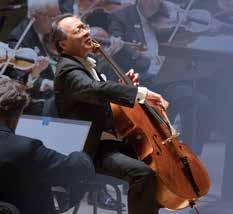
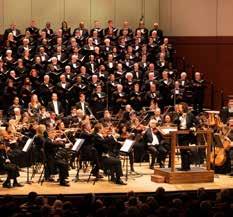
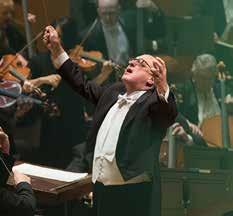
encoreatlanta.com | 15
The Atlanta Symphony Orchestra is grateful to the generous donors who support our Education & Community Engagement Initiatives. The following list represents gifts of $500 or more made since June 1, 2022 in support of the Talent Development Program & the Orchestra’s other education & community programs.
$50,000+
Accenture
Paul M. Angell Family Foundation
The Molly Blank Fund
City of Atlanta Mayor's Office of Cultural Affairs
The Coca-Cola Company
$10,000+
A Friend of the Symphony
John & Juliet Allan
Alston & Bird LLP
Mr. Keith Barnett
BlueLinx
Cadence Bank Foundation
Costco Wholesale
Elaine & Erroll Davis
Ernst & Young
$2,000+
A Friend of the Symphony (2)
Azalea City Chapter of Links
George & Gloria Brooks
Jacqueline A. & Joseph E. Brown, Jr.
Ned Cone & Nadeen Green
Mrs. Nancy Cooke
$500+
Johnnie Booker
Castellini Foundation
Liz & Charlie Cohn
John L. Cromartie II
Mr. & Mrs. Reade Fahs
Sharon, Lindsay and Gordon Fisher
KS Ford
Shirley C. Franklin
Delta Air Lines
Lettie Pate Evans Foundation
Georgia Council for the Arts
Georgia Power
The Goizueta Foundation
Graphic Packaging
The Home Depot Foundation
Abraham J. & Phyllis Katz Foundation
Charles Loridans Foundation, Inc.
Amy W. Norman Charitable Foundation
PNC
The Zeist Foundation, Inc.
Fulton County Arts & Culture
Jeannette Guarner, MD & Carlos del Rio, MD
The Gable Foundation
Georgia-Pacific
The Livingston Foundation, Inc.
Norfolk Southern
Porsche Cars North America, Inc.
Publix Super Markets Charities
Mr. David L. Forbes
Azira G. Hill
International Women’s Forum
Cameron Jackson
Mona & Gilbert Kelly
Donna Lee & Howard Ehni
Ms. Helen Motamen and Mr. Deepak Shenoy
Mary C. Gramling
Charles Ginden
Mr. and Mrs. Mike Griffin
Mrs. Elice D. Haverty
Bill & Kathy Lamar
Ms. Malinda C. Logan
Alan and Amy Manno
John & Linda Matthews
Drs. Price & Jacqueline Michael
Ms. Sharon A. Pauli
The Mark & Evelyn Trammell Foundation
Thomas & Lynne Saylor
The Scott Hudgens Family Foundation
Slumgullion Charitable Fund
Universal Music Group-Task Force For Meaningful Change
Drs. Kevin & Kalinda Woods
Margaret H. Petersen
Ponce de Leon Music Store
Patty & Doug Reid
Cammie & John Rice
The Society, Inc.
TEGNA Foundation
Dr. Brenda G. Turner
Ms. Sonia Witkowski
John and Monica Pearson
Ms. Felicia Rives
Ms. Donata Russell Ross
Dr. La Tanya & Mr. Earl R. Sharpe
Ms. Fawn M. Shelton
Mr. and Mrs. Michael Stinson
Ms. Juliana Taylor
Ms. Mary A. Valdecanas
aso.org | @AtlantaSymphony | facebook.com/AtlantaSymphony
| encore 16
GINO AND BELINDA MASSAFRA
Tireless and Indispensable Leadership
An army of generous volunteers makes it possible for the Atlanta Symphony Orchestra to perform. Over the years, Belinda Massafra has been one of the generals for that army. She and her husband, Gino, have been subscribers and donors for more than three decades.
Belinda, who grew up in Illinois, was a senior manager at BellSouth for many years, including a stint heading up their shareholder services. She later formed a consulting company but is now fully retired. Gino, originally from Connecticut, is an attorney with a practice in Marietta, where they live.
Belinda has long been active with Atlanta Symphony Associates, a volunteer group which has served the Orchestra for 75 years, and she was ASA president from 2010-2012. Belinda is also an active member of the Patron Partnership and Appassionato Leadership Committee (PALS), a unique hands-on donor organization which works directly with the ASO development team to raise money, and she chaired that group from 2015-2018. In 2019, Belinda chaired the ASO Gala, our premiere fundraising event. More recently, Belinda has joined the ASO Advisory Council, a group of passionate donors who are closely engaged with the Orchestra’s leadership.
As ASO Executive Director Jennifer Barlament put it: “Belinda is a powerhouse; she organizes galas and meetings, achieves important fundraising goals, and brings people together with relentless energy, all with her signature charm and constant smile. Among many indispensable volunteer leaders that the ASO has been blessed to have through the years, Belinda shines.”
About being donors Gino said: “I think of it as an investment: to introduce the beauty of classical music to kids and adults who’ve never heard it.” And Belinda added a quote from former ASO Board Chair Howard Palefsky: “Civilization is not free." If we think the arts are important for the civilization we want to live in, then we must support them.

encoreatlanta.com | 17
DONOR PROFILE


We are deeply grateful to the following leadership donors whose generous support has made the Atlanta Symphony Orchestra's season possible.

| 19
encoreatlanta.com
Concerts of Thursday, April 4, 2024, at 8:00 PM
Friday, April 5, 2024, at 8:00 PM
NATHALIE STUTZMANN, conductor
DAVID COUCHERON, violin
ZHENWEI SHI, viola
Presented with generous support by

Thursday’s concert is dedicated to the amazing ASO musicians led by Nathalie Stutzmann, volunteers, Board, chorus, and the ASO staff led by Jennifer Barlament by BILL & RACHEL SCHULTZ.
Friday’s concert is dedicated to SUSIE & PATRICK VIGUERIE in honor of their extraordinary support of the 2022/23 Annual Fund.
JOHANNES BRAHMS (1833–1897)
Variations on a Theme by Haydn, Op. 56a (1873)
Chorale St. Antoni: Andante
Variation I: Poco più animato
Variation II: Più vivace
Variation III: Con moto
Variation IV: Andante con moto
Variation V: Vivace
Variation VI: Vivace
Variation VII: Grazioso
Variation VIII: Presto non troppo
Finale: Andante
WOLFGANG AMADEUS MOZART (1756–1791)
19 MINS
Sinfonia concertante in E-flat Major for Violin and Viola, K. 364 [320d] (1779)
30 MINS
I. Allegro maestoso
II. Andante
III. Presto
David Coucheron, violin
Zhenwei Shi, viola
INTERMISSION
JOHANNES BRAHMS (1833–1897)
Symphony No. 1 in C Minor, Op. 68 (1868)
I. Un poco sostenuto — Allegro
II. Andante sostenuto
III. Un poco Allegretto e grazioso
20 MINS
46 MINS
IV. Adagio — Più andante — Allegro non troppo, ma con brio
The use of cameras or recording devices during the concert is strictly prohibited. Please be kind to those around you and silence your mobile phone and other hand-held devices.
aso.org | @AtlantaSymphony | facebook.com/AtlantaSymphony | apr4/5
20
by Noel Morris Program Annotator notesontheprogram
Variations on a Theme by Haydn, Op. 56a
Johannes Brahms had his critics, yet none was as cruel as Johannes Brahms. He had it in his head that he needed to write a symphony, and he labored for two decades through false starts and feedback sessions. He produced (and destroyed) many compositions but didn’t unveil a symphony until age 43.
First ASO performance:
November 22, 1955
Henry Sopkin, conductor
Most recent ASO performances:
September 21–23, 2000
Robert Spano, conductor
It’s hard to understand his lack of confidence. Apart from writing such great music, he premiered the First Piano Concerto, a massive, 50-minute piece, at 26. He produced his choral masterpiece, A German Requiem, at 35. So, why not a symphony?
In 1873, Brahms launched a trial balloon. In August, he presented a two-piano version of the Variations on a Theme by Haydn to the great pianist Clara Schumann. Side-by-side, the two friends played through the piece. That same summer, Brahms sought further advice. According to biographer Jan Swafford, he made several trips to see “conductor Hermann Levi in Munich, where the two presumably sat working through the scoring” of the Variations. Brahms had studied the Viennese masters his entire life. Although his family had no piano, he studied the instrument with a man whose teachers had personally known the 18thcentury masters Haydn, Mozart and Beethoven. With their music firmly beneath his fingers, Brahms became a lifelong scholar and champion of bygone composers.
At some point, the librarian Carl Ferdinand Pohl showed him a piece for wind band, an outdoor partita titled Chorale St. Antoni, believing it to be the work of Haydn. (Today’s scholars suggest it might be a knockoff peddled by 18th-century publishers.)

The tune feels lopsided. It has five-bar phrases instead of the typical four, which is exactly what appealed to Brahms. He copied it and produced eight variations along with a finale, itself a set of variations based on the Baroque passacaglia. With that, Johannes Brahms put his stamp on the symphony orchestra, spinning a stunning phantasmagoria over a repeated five-bar bass line.
Brahms led the Vienna Philharmonic in the premiere of the Haydn Variations on November 2, 1873. He finished his First Symphony in 1876.
|
21
First ASO performances:
January 22–23, 1959
Henry Sopkin, conductor
Martin Sauser, violin
John Adams, viola
Most recent ASO performances:
October 3–5, 1997
Cecylia Arzewski, violin
Pinchas Zukerman, viola and conductor
Sinfonia concertante in E-flat Major for Violin and Viola, K. 364 [320d]
With a kick in the pants, the Archbishop of Salzburg severed ties with Mozart in 1781. It was terribly humiliating, and quite opportune for the young composer who desperately needed an excuse to leave home. His father, Leopold, had been a devoted parent and teacher but was also guilty of serious overreach. As biographer Maynard Solomon wrote, “Without significant exception, Leopold opposed or interfered with all of his son’s love affairs.”
Four years earlier, Leopold Mozart had sent his wife and son on a job-hunting tour of Germany and Paris. (Wolfgang’s mother was instructed to keep him away from women.) The young composer was out from under his father for the first time and quickly fell into a steamy romance with his cousin in Augsburg. The next stop was Mannheim, where he fell in love with the soprano Aloysia Weber (he’d later marry her sister). He informed his father of his intention to remain with Aloysia’s family, which prompted a fierce response: “Off with you to Paris!”

In general, the tour of 1777–1779 was a bust. Mozart’s mother died tragically, leaving the youth alone in a foreign city where he had to make funeral arrangements and notify the family. Professionally, many of the nobles who had marveled at the prodigy Mozart were less interested in the grown-up version. The Elector of Bavaria expressed reservations about handing a directorship to an untested 22-year-old.
With the passing of his mother, Mozart began to contemplate being his own boss. Anxious to break with Salzburg, he reasoned he could freelance in Germany and be near Aloysia. Leopold quashed the idea, giving him an ultimatum: return home or pay for all the trip’s expenses.
In January 1779, Mozart began his final chapter with the court of Salzburg. While in Paris, he had picked up on a popular
"We really wanted to play Mozart, but as you’re not worthy of it, we shall, for your punishment, play Brahms’s A Major [Sonata for Violin and Piano]."
—Johannes Brahms
aso.org | @AtlantaSymphony | facebook.com/AtlantaSymphony
| encore 22
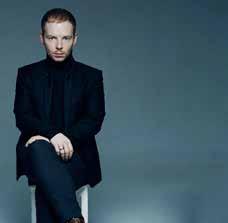





ON SALE NOW aso.org
style of writing orchestral music with multiple soloists, something he continued when he got home. Not quite a concerto, not quite a symphony, the Sinfonia concertante for Violin and Viola from the summer of 1779 is widely considered a masterpiece. Because Mozart wrote the piece at home in Salzburg, he didn’t write letters about its composition, although we do know he loved to play the viola. (Possibly, he performed it himself.) The piece is written in the key of E-flat major—except for the viola part, which is scored in D major with instructions to tune up a semitone. A technique called “scordatura,” this alternate tuning gives an added sheen to the viola sound.
First ASO performance: April 30, 1949
Henry Sopkin, conductor
Most recent ASO performances:
December 2-4, 2021
Donald Runnicles, conductor
Symphony No. 1 in C Minor, Op. 68
Picture a seedy hole in the wall in Hamburg, 1848. Sailors, Hungarian immigrants, and prostitutes huddle around the bar. At a nearby piano, a blondeheaded boy with dreamy blue eyes plays dance tunes and songs on demand—Johannes Brahms had been working there since he was twelve.
Although formal education ended for him at 14, he was an avid reader and was said to keep his nose in a book as his fingers plinked at that piano. The son of a seamstress and a musician, little “Hannes” showed an early affinity for music. To pay for lessons, his parents made sacrifices and became the first in a series of people who went out of their way to open doors for him.
Sensing the boy was more talented than himself, his first music teacher petitioned for a better teacher. That person taught him at no charge. Others provided places for Brahms to practice. In 1853, a Hungarian violinist introduced him to the famous violin virtuoso Joseph Joachim.
“Never in the course of my artist’s life have I been so completely overwhelmed,” recalled Joachim. In the shy, 20-year-old Brahms, he saw something “noble and inspired.” He introduced him to Robert and Clara Schumann (Robert was a respected composer and critic; Clara was a famous pianist). Playing his Piano Sonata in C major, Brahms hit the Schumanns like a thunderbolt. Things unfolded rapidly after that; people declared him the heir to Beethoven. His new friends urged him to write a symphony (just as Beethoven had done). He wasn’t ready.
Brahms wrote a lot of piano music in those days but was eager to please. Seeing greater potential in his Two Piano Sonata in D minor,
aso.org | @AtlantaSymphony | facebook.com/AtlantaSymphony
24 | encore
he attempted to refashion it as a symphony. After laboring through the summer of 1854, he showed his work to Joachim, who was impressed. Brahms scolded him.
“As usual, you have regarded the movement of my Symphony through a rose-colored glass,” the composer moaned. “I must alter and improve it all through.” That D-minor Symphony never materialized. We know its music today as the Piano Concerto No. 1.
There would be other false starts. In 1854, Brahms took a position as the director of the Court Concerts and Choral Society in LippeDetmold. A cushy job for a 21-year-old, it provided him free access to a fine orchestra. For that orchestra, he wrote two serenades, each approaching a symphony in scale. For a while, he made noise about expanding these works into symphonies but later abandoned the idea.
On July 1, 1862, eight years later, Clara wrote to Joachim: “Johannes sent me the other day—imagine my surprise!—the first movement of a symphony.” She went on to say it is “full of wonderful beauties” and copied down some of the music in the letter. From her sketch, we can recognize the first movement of Brahms’s First Symphony. But it would continue to percolate for another 14 years.
The next whiff of the First Symphony came in 1868. While vacationing in Switzerland with his father, the composer wrote a melody over the following words: “High on the mountain, deep in the valley, I greet you a thousandfold,” and sent it to Clara. Eight years later, that melody became a horn call in the Symphony’s finale.
Although writing symphonies eluded Brahms for years, he was far from unproductive. Becoming one of Europe’s most famous composers, he wrote songs, choral works, chamber works, his German Requiem, and the Haydn Variations.
The final symphonic push came in the summer of 1876 between swims off the Isle of Rügen; Brahms committed much of his Symphony No. 1 to paper there. He added the finishing touches in Lichtental. At the premiere in November, conductor Hans von Bülow noted echoes of Beethoven’s Ninth, to which Brahms snapped, “Any jackass can see that!”
encoreatlanta.com | 25
meettheartists

DAVID COUCHERON, violin
David Coucheron joined the Atlanta Symphony Orchestra as Concertmaster in September 2010. At the time, he was the youngest concertmaster in any major U.S. orchestra. Throughout his career, Coucheron has worked with conductors Robert Spano, Michael Tilson Thomas, Simon Rattle, Mstislav Rostropovich and Charles Dutoit, among others. He has performed as soloist with the BBC Symphony Orchestra, Bergen Philharmonic Orchestra, Sendai Symphony Orchestra, Oslo Philharmonic Orchestra and the Trondheim Symphony Orchestra.
Coucheron has given solo recitals at Carnegie Hall, Wigmore Hall, the Kennedy Center and the Olympic Winter Games (Salt Lake City, Utah), as well as in Beograd, Chile, China, Hong Kong, Japan, Serbia, Singapore and Shanghai. His chamber music performances have included appearances at Suntory Hall as well as Wigmore Hall and Alice Tully Hall. Coucheron serves as the Artistic Director for the Kon Tiki Chamber Music Festival in his hometown of Oslo, Norway. He is also on the artist-faculty for the Aspen Music Festival and Brevard Music Festival.
An active recording artist, recordings with sister and pianist Julie Coucheron include “David and Julie” (Naxos/Mudi) and “Debut” (Naxos). He is also the featured soloist on the Atlanta Symphony Orchestra’s recording of Vaughan Williams’ The Lark Ascending, which was released on ASO Media in Fall 2014.
Coucheron began playing the violin at age three. He earned his Bachelor of Music degree from The Curtis Institute of Music, his Master of Music from The Juilliard School and his Master of Musical Performance from the Guildhall School of Music and Drama, studying with teachers including Igor Ozim, Aaron Rosand, Lewis Kaplan and David Takeno. Coucheron plays a 1725 Stradivarius, on kind loan from Anders Sveaas Charitable Trust.
aso.org | @AtlantaSymphony | facebook.com/AtlantaSymphony |
26
ZHENWEI SHI, viola
Zhenwei Shi was appointed principal violist of the Atlanta Symphony Orchestra in 2019 at the age of twenty-three.
He received first prize in the 2010 International String Players Competition in Hong Kong and third prize in the 2014 Johansen International Young String Players Competition in the U.S.A. He was also awarded the Special Jury Prize from the 2016 XII Lionel Tertis Viola International Competition and the Regent’s Award from the Duchess of Gloucester of British Royalty and Royal Academy of Music.
As a Drake Calleja Trust and ABRSM scholar in the U.K. since 2016, Mr. Shi has performed as a solo violist and chamber musician at prestigious venues such as Buckingham Palace, Wigmore Hall, Royal Festival Hall, Shanghai Concert Hall, and on the BBC’s In Tune broadcast.
Since 2018, he has been a frequent guest player with the San Francisco Symphony and Chicago Symphony Orchestra. Mr. Shi has performed with the Georgian Chamber Players since 2019. He was invited to be an artist-faculty member at the Aspen Music Festival and School in 2020. encoreatlanta.com


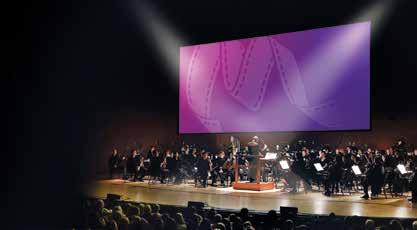
| 27
Concerts of Thursday, April 11, 2024, at 8:00 PM
Saturday, April 13, 2024, at 8:00 PM
NATHALIE STUTZMANN, conductor
RENÉE FLEMING, soprano
RICHARD STRAUSS (1864–1949)
Sextet from Capriccio, Op. 85 (1941) 11 MINS
Vier letzte Lieder (Four Last Songs) (1948)
I. Frühling (Spring)
II. September
Presented with generous support by

24 MINS
III. Beim Schlafengehen (At Bedtime)
IV. Im Abendrot (At Sunset)
Renée Fleming, soprano
INTERMISSION
RICHARD STRAUSS (1864–1949)
Four Orchestral Songs
“Waldseligkeit,” Op. 49, No. 1 (1901, orch. 1918)
“Muttertändelei,” Op. 43, No. 2 (1899, orch. 1900)
20 MINS
10 MINS
“Traum durch die Dämmerung,” Op. 29, No. 1 (1895, orch. Robert Heger)
“Zueignung,” Op. 10, No. 1 (1885, orch. Robert Heger)
Renée Fleming, soprano
Suite from Der Rosenkavalier, Op. 59 (1909–1910, arr. 1944)
25 MINS
aso.org | @AtlantaSymphony | facebook.com/AtlantaSymphony
The use of cameras or recording devices during the concert is strictly prohibited. Please be kind to those around you and silence your mobile phone and other hand-held devices.
28 | apr11/13
by Noel Morris Program Annotator
Strauss was an exceptional child. Composing his first song at the age of six, he couldn't yet command his fingers to print letters small enough to write words between the staves, so he asked for his mother’s help.
Young Strauss grew up around the lions of 19th-century music. His father, Franz, was a famous French horn player at the Munich Court Opera. Richard described him as “vehement, irascible, tyrannical.” A militant musical conservative, Franz Strauss railed against the modern sounds coming from the pens of Wagner and Liszt and schooled his son on the virtues of Haydn and Beethoven. Young Richard learned the piano, followed his father to opera rehearsals, and wrote pages and pages of music in the classical model.
“[Franz] Strauss is a detestable fellow,” quipped Richard Wagner. “But when he plays the horn, you can't be angry with him.” Ironically, the elder Strauss fathered a giant of modernism.
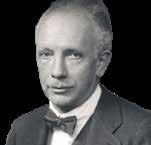
“I still remember very well how, at around 17 years of age, I almost feverishly swallowed the score of [Wagner's] Tristan and fell into a frenzy of enthusiasm,” he wrote.
The Munich Court Opera was the perfect incubator for a future opera composer. Year after year, Richard Strauss heard the greatest singers of his day, witnessed landmark productions, and developed a keen sense of storytelling through music. He learned his way around an orchestra and won his first conducting job at 21. At 22, he became the third conductor at his father’s opera company.
Over the coming decades, Strauss became one of the most successful composers alive. His symphonic poems instantly entered the repertoire. So popular was his opera Der Rosenkavalier that additional trains had to be scheduled to ferry audiences into Dresden. When Kaiser Wilhelm II suggested that Strauss’ scandalous opera Salome had damaged his reputation, Strauss laughed: “That damage paid for my villa in Garmisch.”
Capriccio
Capriccio is the last of Strauss’ 15 operas, written during the ravages of World War II. A throwback to a simpler age, the story seems frivolous or, at least, oddly detached from the events of the time. Its languid characters lounge
First and most recent ASO performances: February 5-7, 2009, Donald Runnicles, conductor
notesontheprogram |
29
around a French chateau as a composer and a poet compete for the affections of a young countess. Each man offers expansive testimonials arguing for the superiority of his respective art form (words vs. music), giving the opera’s subtitle, “A Conversation Piece for Music,” an almost academic spin. Nevertheless, the music is marvelous. Capriccio takes the form of an opera-within-an-opera, with the lush Sextet serving as both an overture and a composition by the character Flamand. In the end, after much peacocking, the Countess praises the union of words and music and chooses not to choose.
First ASO performances:
January 30–31, 1958, Henry Sopkin, conductor, Lisa Della Casa, soprano
Most recent ASO performances: December 2-4, 2021, Donald Runnicles, conductor, Jacquelyn Stucker, soprano
Four Last Songs
World War II clouded Strauss’ later years. In 1933, he was 70 years old when Hitler came to power. Consistently an apolitical man, Strauss defied the Third Reich and continued to work with his Jewish librettist, Stefan Zweig. At the same time, he complied with party officials, conducting concerts and writing music on demand. Soon he ran afoul of both Zweig and the Nazis. The latter took dramatic steps to isolate him and nearly robbed him of his family (his beloved daughter-in-law, Alice, and grandchildren were Jewish). As it happened, Strauss retained just enough influence to save them, but Alice lost her extended family. By war’s end, the touchstones of his career— the bejeweled opera houses of Berlin, Vienna, Dresden, and Munich—fell to allied bombs. And the composer was a broken man.
Now in his eighties, post-war Strauss became a different composer. His bold and experimental writing style grew nostalgic, reflective and autumnal. In the spring of 1848, he wrote a song on a poem by Joseph von Eichendorff about a couple in the twilight of life, “Im Abendrot.”
In it, he makes a passing reference to his 1890 tone poem Death and Transfiguration. Over the summer, he composed another three songs based on poems by Hermann Hesse. A year later, Strauss died. Pauline passed eight months after that.
Soon after the composer’s death, Ernst Roth, chief editor at the publisher Boosey & Hawkes, bundled the songs into a cycle called Four Last Songs.
These are the first ASO performances.
Four Orchestral Songs
Strauss was lucky in life and lucky in love. In 1894, he was in the throes of a chaotic and heated rehearsal when his
aso.org | @AtlantaSymphony | facebook.com/AtlantaSymphony
| encore 30
star soprano, Pauline de Ahne, hurled her score at him and stormed off the stage. The maestro followed her, leaving the musicians and singers confused and embarrassed. After a while, Strauss returned to the podium and announced his engagement to Pauline. From then on, hers was the sound that filled his head. Over his lifetime, Strauss wrote 16 operas and more than 200 songs. Incredibly, he wrote songs in every decade of his life.
“Zueignung” is the earliest of this set, written when the composer was 21 years old. It’s easy to think of these as autobiographical: He composed the love song “Traum durch die Dämmerung” a year after he married Pauline. He wrote the 1899 song “Muttertändelei” (Mother Chatter) as two-year-old Franz toddled at his feet. “Waldseligkeit,” another love song, followed in 1901.
Suite from Der Rosenkavalier
By 1903, Strauss had issued two operas without success. He turned to the scandalous play Salomé by Oscar Wilde for his next effort. Strauss’ Salome premiered in Dresden at the end of 1905 and reportedly drew 38 curtain calls. Within two years, some 50 other productions popped up across Europe, giving the composer a fat bank account. He followed Salome with another horror show, the opera Elektra (1909), and then made a hard turn away from things dark and gruesome.
First ASO performance:
March 8–11, 1973, Jacques Houtmann, conductor
Most recent ASO performances:
February 16–19, 2012, Roberto Minczuk, conductor
Der Rosenkavalier, the Knight of the Rose, presents an idealized Vienna. It takes place in the 18th century, with its imperial palaces, powdered wigs, and puffy gowns but with the magic and nostalgia of the Viennese waltz (which came along a hundred years later). Completing the opera in 1911, Strauss melded bygone eras to produce a lush opera that dazzles the eyes and ears with sumptuousness, comedy, bittersweetness and social commentary.
The story features a love triangle using three women’s voices (one of these is a “pants role”). Over the course of the opera, the “aging” Marschallin (she’s only 32) wistfully acquiesces to the march of time and nudges her young lover into the arms of his beloved.
Der Rosenkavalier became one of the most successful operas of all time. In 1945, American soldiers selected Strauss’ villa in Garmisch as a military headquarters. When they entered the house to oust its occupants, the white-haired Strauss announced, “I am Richard Strauss, composer of Der Rosenkavalier and Salome.” The soldiers left the house untouched.
31 encoreatlanta.com |
32 | meettheartists

www.reneefleming.com
Renée Fleming appears by arrangement with IMG Artists, www.imgartists.com.
Ms. Fleming is an exclusive recording artist for Decca and Mercury Records (UK). Ms. Fleming’s jewelry is by Ann Ziff for Tamsen Z.
RENÉE FLEMING, soprano
Renée Fleming is one of the most highly acclaimed singers of our time, performing on the stages of the world’s great opera houses and concert halls. Honored with five Grammy® awards and the US National Medal of Arts, she has sung for momentous occasions from the Nobel Peace Prize ceremony to the Super Bowl. A Goodwill Ambassador for Arts and Health for the World Health Organization, in December she was awarded the prestigious Kennedy Center Honor.
Renée’s new anthology, Music and Mind: Harnessing the Arts for Health and Wellness, will be published by Penguin Random House on April 9, 2024. A prominent advocate for research at the intersection of arts, health, and neuroscience, as Artistic Advisor to the Kennedy Center for the Performing Arts Renée launched the first ongoing collaboration between America’s national cultural center and the National Institutes of Health. She created her own program called Music and the Mind, which she has presented in more than fifty cities around the world.
Renée’s current concert calendar includes appearances in Paris, Milan, Vienna, and at Carnegie Hall. Recent opera performances include starring in the world premiere staging of The Hours, a new opera based on the Pulitzer Prize-winning novel and award-winning film, at the Metropolitan Opera, and a role debut as Pat Nixon in a new production of Nixon in China at the Opéra de Paris.
In 2023, Decca released a special double-length album of live recordings from Renée’s iconic performances at the Metropolitan Opera, Renée Fleming: Greatest Moments at the Met. Renée has recorded everything from complete operas and song recitals to indie rock and jazz. She earned a Tony award nomination for her performance in Carousel on Broadway, and her voice is featured in two Best Picture Oscar-winning films.
In addition to directing SongStudio at Carnegie Hall, Renée is CoArtistic Director of the Aspen Opera Theater and VocalARTS at the Aspen Music Festival and School and Advisor for Special Projects at the Los Angeles Opera. Other awards include the 2023 Crystal Award from the World Economic Forum, the Fulbright Lifetime Achievement Medal, and the Order of Merit from Germany. She holds honorary doctorates from eight leading universities.
aso.org | @AtlantaSymphony | facebook.com/AtlantaSymphony


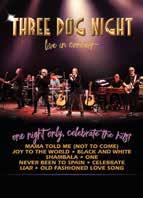

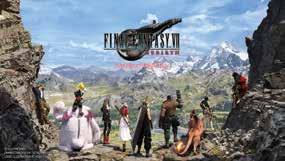
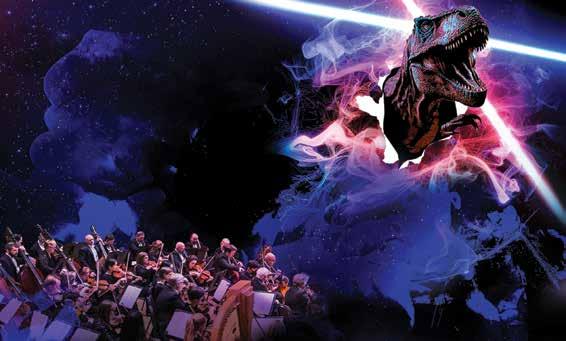

Concerts of Thursday, April 18, 2024, at 8:00 PM
Saturday, April 20, 2024, at 8:00 PM
NATHALIE STUTZMANN, conductor
MARIA JOÃO PIRES, piano
FELIX MENDELSSOHN (1809–1847)
Overture, The Hebrides (Fingal’s Cave), Op. 26 (1830–1832)
10 MINS
Presented with generous support by

LUDWIG VAN BEETHOVEN (1770–1827)
Piano Concerto No. 4 in G Major, Op. 58 (1806)
I. Allegro moderato
II. Andante con moto
III. Rondo: Vivace
Maria João Pires, piano
INTERMISSION
ROBERT SCHUMANN (1810–1856)
Symphony No. 4 in D Minor, Op. 120 (1841, rev. 1851)
I. Ziemlich langsam — Lebhaft
II. Romanze: Ziemlich langsam
III. Scherzo: Lebhaft
IV. Langsam — Lebhaft
Thursday’s concert is dedicated to BETTY AND BOB EDGE in gratitude for their endless support of the Atlanta Symphony Orchestra, contributions to the Atlanta music community and for the scholarly education we have gained from Bob’s revered music lectures.
use of cameras or recording devices
34 MINS
20 MINS
28 MINS
Thursday’s concert is dedicated to PATTY & DOUG REID in honor of their extraordinary support of the 2022/23 Annual Fund.
Saturday’s concert is dedicated to JUNE & JOHN SCOTT in honor of their extraordinary support of the 2022/23 Annual Fund.
concert is strictly prohibited. Please be kind to those around you and silence your mobile phone and other hand-held devices.
The
during the
34 | apr18/20
notesontheprogram
Overture, The Hebrides (Fingal’s Cave), Op. 26
Once upon a time, a Grand Tour signaled the coming of age for a young gentleman. Following a course through France, Italy and Germany, the young traveler visited a list of must-see sites, antiquities, and works of art. But young Felix Mendelssohn was not the typical young traveler.
by Noel Morris Program Annotator
First ASO performance: March 2, 1950
Henry Sopkin, conductor
Most recent ASO performances: February 27–March 1, 2014
Thierry Fischer, conductor
“The boy was born on a lucky day,” said the poet Johann Wolfgang von Goethe. Mendelssohn was just 16 when he composed his first masterpiece. The son of a banker, Mendelssohn received the best instruction available, excelling in literature, languages, geography, math and drawing. His parents cultivated a home life that was the envy of Europe, a gathering place for famous poets, scientists, writers, musicians, artists and thinkers in Berlin—a host of celebrities who came and marveled at the two Mendelssohn prodigies (Felix and his sister, Fanny). These musical siblings could dazzle the room with their performances. On quieter evenings, the family read aloud, sometimes acting out favorite adventures by Sir Walter Scott. When the 21-year-old Felix embarked upon his Grand Tour, he was already an authority on many of Europe’s treasures and customized his trip accordingly.
“Next August, I am going to Scotland, with a rake for folksongs, an ear for lovely fragrant countryside, and a heart for the bare legs of the natives,” he wrote to a friend in March of 1829. “Klingemann, you must join me; we may lead a merry life!” And they did. On August 8, they boarded the steamer Ben Lomond to sail around the Hebrides (pron. HEH bri DEEZ), an island chain off the northwest coast known for its striking, cathedral-like rock formations, aquamarine waters, and verdant, wind-swept hills. The boys lucked into calm weather and went ashore at Fingal’s Cave.

“We were put out in boats and lifted by the hissing sea up the pillar stumps,” wrote Klingemann. “A greener roar of waves never rushed into a stranger cavern—its many pillars making it look like the inside of an immense organ.”
The almost man-made-looking rock formations especially impressed young Mendelssohn, who wrote home to Berlin, “In order to make you understand how extraordinarily the Hebrides affected me, the following came into my mind there.” And he wrote 20 bars of music, the opening of his Hebrides Overture.
35
|
He left further clues about the roiling, haunting atmosphere of the Overture in his artwork, which shows heavy cloud cover and dramatic landscapes rising from misty waters.
After the British Isles, Mendelssohn went on to sunny Italy, where he began his famous “Italian” Symphony. He finished the first draft of the Hebrides Overture on his father’s birthday, December 11, 1830.
First ASO performance:
March 21, 1951
Henry Sopkin, conductor
Claudio Arrau, piano
Most recent ASO performances:
January 12–15, 2023
Kazem Abdullah, conductor
Tom Borrow, piano
Piano Concerto No. 4 in G Major, Op. 58
“Inspirational bedlam,” wrote biographer Edmund Morris. That’s how he described Beethoven’s sketchbooks. Between 1803 and 1804, Beethoven was a fountain of ideas; he jotted down hundreds of sketches and bound them into a 192-page book. About half of these went into the “Eroica” Symphony. Other fragments found their way into the Fifth and Sixth Symphonies, the opera Fidelio, his Triple Concerto and his Fourth Piano Concerto.
At the turn of the century, Beethoven was the most famous pianist in Vienna. Excelling on an instrument that had only recently become widespread, he was, for all practical purposes, a first-generation player. (Consider that Mozart, who was only 15 years older, began life as a harpsichordist.) Unlike Mozart, Beethoven spent his youth practicing on this new invention and had a different sense of its dramatic potential. The noble houses of Vienna happily opened their doors to the temperamental Beethoven. And he wrote music to show off his skills.
At that point, the audience knew the concerto formula: The orchestra would play some tunes. Then, the pianist would play them. With the Fourth Piano Concerto, Beethoven surprised listeners by opening with the piano alone. Marked by exquisite serenity, the music grows from a four-note figure that forms the glue for the entire movement, shifting and flowing through varying shades and colors. (It’s no coincidence that the raging Fifth Symphony also grows from that four-note figure; the opening music of each piece appears side-byside in Beethoven’s sketchbook.)
Sadly, the bedlam described by Edmund Morris was not limited to Beethoven’s sketchbooks. In the year 1806, the composer suffered chronic illness and profound hearing loss. He had a spat with his theater manager and withdrew his opera. He quarreled with his brother and his publisher. He lost his stipend after an argument
aso.org | @AtlantaSymphony | facebook.com/AtlantaSymphony
36 | encore
with his patron. Despite all this, Beethoven produced one landmark piece after another, including quartets, the Fourth Symphony, and the Violin Concerto. He also worked on his Fifth Symphony and finished his Fourth Piano Concerto. The Concerto had its public premiere on a bone-chilling night in 1808. In what was a legendary fiasco, Beethoven drew an audience into an unheated hall for what turned out to be a whopping four-hour concert. Leading a disgruntled and under-rehearsed orchestra, he presided over a series of misfires as he premiered the Fourth Piano Concerto, the Fifth Symphony, the Sixth Symphony, and the Choral Fantasy. After its chilly debut, the Fourth Piano Concerto languished until 1836 (nearly a decade after Beethoven’s death) when Felix Mendelssohn revived the piece.

Symphony No. 4 in D Minor, Op. 120
In May of 1841, Robert Schumann was riding high. He had recently married the love of his life; he had a baby on the way, and his First Symphony was a resounding success. He could look back on a journey of self-discovery, which started with a pivot from studying law to studying piano at the age of 20.
First ASO performances:
November 20–22, 1969
James Levine, conductor
Most recent ASO performances:
October 21–24, 2021
Juanjo Mena, conductor
In 1830, he quit university and moved in with his piano teacher, Friedrich Wieck, where he became one of two star piano students— the other was Wieck’s 9-year-old daughter, Clara, a child prodigy. As months turned into years, Clara grew on Robert. By age 15, her father felt he needed to run interference and keep her away from the temperamental young man. Now a formidable virtuoso, Clara went on a series of concert tours that practically drove her into Robert’s arms. They set up a secret system to exchange letters, and their love blossomed.
In September 1840, the day before her 21st birthday, Clara and Robert exchanged wedding vows. By then, Robert had shifted his focus toward composition and music journalism. That same year, with his head filled with love and romance, he wrote more than 150 songs.
In January 1841, Schumann turned his focus to the orchestra, completing a draft of his First Symphony in just four days. Two months later, Felix Mendelssohn conducted the premiere, and
encoreatlanta.com | 37
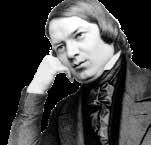
Schumann immediately found a publisher. Continuing at a dizzying pace, Schumann wrote the Overture, Scherzo and Finale, and the first movement of what became the Piano Concerto—all before the fall.
For her part, Clara treated her husband’s composition career like a family business.
“Robert’s mind is very creative now, and he began a symphony yesterday which is to consist of one movement, but with an Adagio and finale,” she wrote toward the end of May. “I have heard nothing of it yet, but from seeing Robert’s doings and D minor echoing wildly in the distance, I know in advance that this will be another work emerging from the depths of his soul.” This time, Robert aspired to create something different: instead of writing a symphony in which each movement is effectively a unique piece of music (which, for the most part, was the norm up until that point), he fashioned a far more integrated work, building each movement out of material from the symphony’s opening bars.
The premiere took place on December 6, 1841. This time, Mendelssohn was unavailable to conduct, so Clara stepped in as a headliner alongside piano superstar Franz Liszt. They played a duet together, and Schumann’s D-minor symphony received its first performance. The piece elicited mixed reactions. Schumann’s publisher declined to take it on, and he set it aside.
After taking a break from the symphonic form, Schumann wrote the piece now known as Symphony No. 2 in 1845 and followed it with the Symphony No. 3 in 1850.
Around that time (1850), Schumann accepted a position as music director of the orchestra and choral society in Düsseldorf. It was for the Lower Rhenish Music Festival that he returned to his D-minor Symphony. Reworking whole sections, adding transitions, and thickening the orchestration, he reissued the D minor Symphony at the festival in 1853. It came to be known as Symphony No. 4.
aso.org | @AtlantaSymphony | facebook.com/AtlantaSymphony
38 | encore
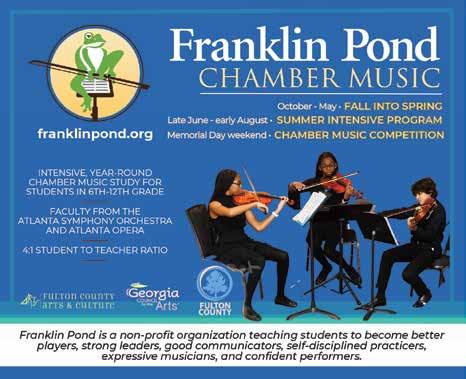

meettheartists

MARIA JOÃO PIRES, piano
Born in 1944 in Lisbon, Maria João Pires gave her first public performance at the age of 4 and began her studies of music and piano with Campos Coelho and Francine Benoît, continuing later in Germany, with Rosl Schmid and Karl Engel. In addition to her concerts, she has made recordings for Erato for fifteen years and Deutsche Grammophon for twenty years.
Since the 1970s, she has devoted herself to reflecting the influence of art in life, community, and education, trying to discover new ways of establishing this way of thinking in society. She has searched for new ways which, respecting the development of individuals and cultures, encourage the sharing of ideas.
In 1999, she created the Belgais Centre for the Study of the Arts in Portugal. Maria João Pires regularly offers interdisciplinary workshops for professional musicians and music lovers. In the Belgais concert hall concerts and recordings regularly take place. In future, these will be shared with the international digital community (pay and non-pay).
In 2012, in Belgium, she initiated two complementary projects; the Partitura Choirs, a project which creates and develops choirs for children from disadvantaged backgrounds as in Belgium the Hesperos Choir, and the Partitura Workshops. All of the Partitura projects aim to create an altruistic dynamic between artists of different generations by proposing an alternative in a world too often focused on competitiveness. This philosophy is being spread worldwide at Partitura projects and workshops.
aso.org | @AtlantaSymphony | facebook.com/AtlantaSymphony
|
40
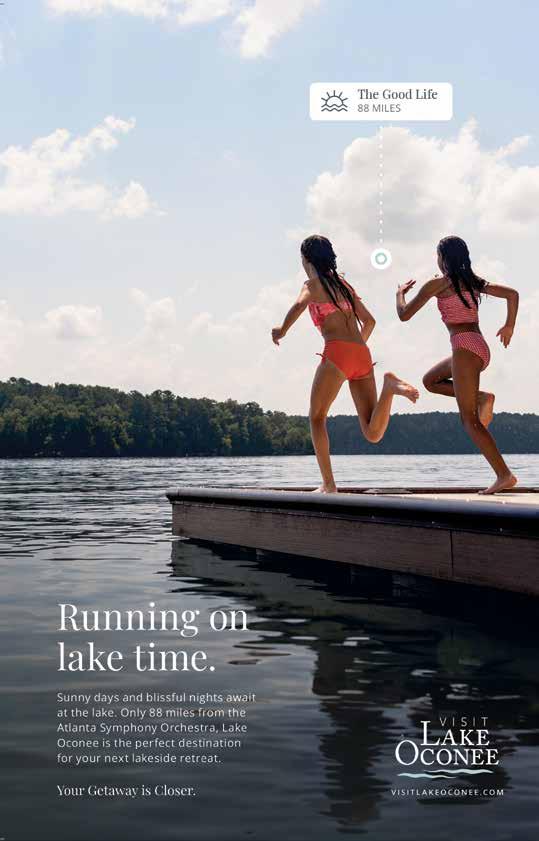
Concerts of Thursday, April 25, 2024, at 8:00 PM
Friday, April 26, 2024, at 8:00 PM
LINA GONZALEZGRANADOS, conductor
CÉDRIC TIBERGHIEN, piano
To See the Sky is an Atlanta Symphony Orchestra Co-Commission with the American Composers Forum, New York Philharmonic, Aspen Music Festival and School, and Bravo! Vail Music Festival.
GABRIELA ORTIZ (b. 1964)
Kauyumari (Blue Deer) (2021)
GEORGE GERSHWIN (1898–1937)
7 MINS
Rhapsody in Blue (1924, orch. 1926 by F. Grofé) 17 MINS Cédric Tiberghien, piano
JOEL THOMPSON (b. 1988)
To See the Sky (2024)
INTERMISSION
GABRIELA LENA FRANK (b. 1972)
20 MINS
20 MINS
This week’s concerts are dedicated to ANGELA EVANS in honor of her extraordinary support of the 2022/23 Annual Fund.
Walkabout, Concerto for Orchestra (2016) 30 MINS
I. Soliloquio Serrano
II. Huaracas
III. Haillí
IV. Tarqueada
ARTURO MÁRQUEZ (b. 1950)
Danzón No. 2 (1994)
10 MINS
Commissions of new works are made possible by THE ROBERT SPANO FUND FOR NEW MUSIC, established with a lead gift from The Antinori Foundation.
The use of cameras or recording devices during the concert is strictly prohibited. Please be kind to those around you and silence your mobile phone and other hand-held devices.
42 | apr25/26
by Noel Morris Program Annotator notesontheprogram
Kauyumari (Blue Deer)
Born to a musical family, Gabriela Ortiz has always felt she didn’t choose music—music chose her. Her parents were founding members of the group Los Folkloristas, a renowned music ensemble dedicated to performing Latin American folk music. Growing up in the cosmopolitan thriving metropolis of Mexico City, Ortiz’s music education was multifaceted. While playing charango and guitar with her parents’ group, she was also learning classical piano. Ortiz began her composition studies under the mentorship of renowned Mexican composers Mario Lavista, Julio Estrada, Federico Ibarra, and Daniel Catán. Later, she continued her studies in Europe, earning a doctorate in composition and electronic music from London’s City University under the guidance of Simon Emmerson.
These are the first ASO performances.
Ortiz’s music incorporates seemingly disparate musical worlds, from traditional and popular idioms to avant-garde techniques and multimedia works. This is, perhaps, the most salient characteristic of her oeuvre: an ingenious merging of distinct sonic worlds. While Ortiz continues to draw inspiration from Mexican subjects, she is interested in composing music that speaks to international audiences.
Ortiz currently teaches composition at Mexico’s National Autonomous University. Her music is published by Boosey & Hawkes.
From the composer:
Among the Huichol people of Mexico, Kauyumari means "blue deer." The blue deer represents a spiritual guide, one that is transformed through an extended pilgrimage into a hallucinogenic cactus called peyote. It allows the Huichol to communicate with their ancestors, do their bidding, and take on their role as guardians of the planet. Each year, these Native Mexicans embark on a symbolic journey to "hunt" the blue deer, making offerings in gratitude for having been granted access to the invisible world, through which they also are able to heal the wounds of the soul.

When I received the commission from the Los Angeles Philharmonic to compose a piece that would reflect on our return to the stage following the pandemic, I immediately thought of the blue deer and its power to enter the world of the intangible as akin to a celebration of the reopening of live music. Specifically, I thought of a Huichol melody sung by the De La Cruz family—dedicated to recording ancestral folklore—that I used for the final movement
43
|
of my piece, Altar de Muertos (Altar of the Dead), commissioned by the Kronos String Quartet in 1997. I used this material within the orchestral context and elaborated on the construction and progressive development of the melody and its accompaniment in such a way that it would symbolize the blue deer. This in turn was transformed into an orchestral texture which gradually evolves into a complex rhythm pattern, to such a degree that the melody itself becomes unrecognizable (the imaginary effect of peyote and our awareness of the invisible realm), giving rise to a choral wind section while maintaining an incisive rhythmic accompaniment as a form of reassurance that the world will naturally follow its course.
Rhapsody in Blue
It was the post-holiday hangover.
First ASO performance:
January 29, 1950, Henry Sopkin, conductor, Oscar Levant, piano
George Gershwin, his brother Ira, and Buddy De Sylva were shooting pool in the wee hours of January 3, 1924, when Ira noticed a newspaper article: “Paul Whiteman is giving a concert of experimental music next month … Jazz! Classical music! … Married together!” It went on to say that George Gershwin would play a new piano concerto. That’s when George learned he had just over a month to write the piece.
Most recent ASO performances:
May 10-12, 2012, Robert Spano, conductor, Leon Bates, piano
Paul Whiteman was one of the most popular bandleaders of the Prohibition era, performing “sweet jazz,” a style characterized by square rhythms and sentimental melodies (as opposed to the “hot jazz” coming from artists like Duke Ellington). With his “Experiment in Modern Music,” Whiteman aspired to make the case for jazz to a broader audience.
George Gershwin was a child of New York’s Lower East Side, a cultural and musical mosaic (roughly a third of New York was foreignborn). The son of Russian immigrants, Gershwin, née Gershowitz, spent a happy childhood roaming the streets of the Yiddish Theater District. Live music was in the air, and when jazz became a fixture in Harlem, young Gershwin lapped it up.
If New York City gave him the musical vocabulary for Rhapsody in Blue, a trip to Boston gave him the inspiration. “It was on that train,” he said, “with its steely rhythms, its rattlety-bang that is so often stimulating to a composer … I suddenly heard—and even saw on
aso.org | @AtlantaSymphony | facebook.com/AtlantaSymphony
44 | encore
paper—the complete construction of the rhapsody from beginning to end.”
Five weeks before the premiere, Gershwin disappeared into the back room of his parents’ apartment and began. He opened the piece with a trill in the solo clarinet moving into a rising scale. In rehearsal, clarinetist Ross Grossman was clowning around and played the scale as one long, sassy glissando. Gershwin wrote it down.
On February 12, 1924—100 years ago—New Yorkers crowded into Aeolian Hall. Imagine this audience: Fred and Adele Astaire, Igor Stravinsky, Jascha Heifetz, Fritz Kreisler, Sergei Rachmaninov, Leopold Stokowski, Deems Taylor, Olin Downes and John Philip Sousa—they were all there. George played the solo piano. Brother Ira, the genius wordsmith, came up with the title. George had suggested “An American Rhapsody,” but Ira said, “No—Rhapsody in Blue.”
To See the Sky Notes on the Program
by Lara Pellegrinelli
JThese are the first ASO performances.
oel Thompson, currently the inaugural Composer-in-Residence at Houston Grand Opera, has a special affinity for working with voices. “The world would be so much better if everyone sang in a chorus,” he says in earnest. “I really do. Call me idealistic and naive, but it's one of the few spaces in which people can come together, sync up their heart rates, and seek beauty together.”
A choral conductor by training, Thompson most often writes topical compositions that engage in racial and social justice issues. His bestknown work, Seven Last Words of the Unarmed for men’s chorus, parallels the liturgical structure of Haydn’s The Seven Last Words of Christ, powerfully setting the final words of Michael Brown, Trayvon Martin, Oscar Grant, Eric Garner, Kenneth Chamberlain, Amadou Diallo, and John Crawford, all unarmed Black men who died at the hands of law enforcement. The piece received the Hermitage Prize at the Aspen Music Festival in 2017, where Thompson was then studying as a Composition Fellow with Stephen Hartke and Christopher Theofanidis, and the 2018 American Prize in Choral Composition.
The Snowy Day, Thompson’s opera based on the Caldecott Medalwinning children’s book by Ezra Jack Keats, follows its young black protagonist Peter into a magically transformed urban landscape. Thompson has composed music for voices on the topic of bus encoreatlanta.com
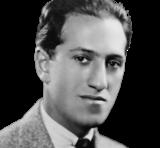
| 45
boycotts, on poetry written by incarcerated people in Michigan’s prisons, and on the texts of Black authors such as Paul Lawrence Dunbar, Joseph Seamon Cotter, Jr., and James Baldwin. Even Thompson’s first orchestral work, Act of Resistance, features voices, giving members of the orchestra the option of putting down their instruments to stand up and sing the word “love.”
“That's the whole point,” he explains. “I wanted to create a situation in which the musician has to embody what love feels like. It can be perceived as cheesy, but it requires them to stop everything that they have been trained to do and be as vulnerable as possible with the voice that they have been given.”

Although there will not be any singing in tonight’s performance of Thompson’s newest orchestral work, To See the Sky, the piece was inspired by the line from a song that has personal meaning to him: “Thunderclouds” by MacArthur award-winning jazz vocalist Cécile McLorin Salvant. “She's probably my favorite artist alive right now,” Thompson says. “I'm obsessed with her.” Buoyed by an aspiration to live beyond his experiences of Black trauma, Thompson has given the musicians soaring melodies layered with percussion lines full of rhythmic play, a language that is at once the descendent of late 19th century Romanticism and traditions of the African diaspora. His previous work for the New York Philharmonic, “The Places We Leave” for countertenor, written for Anthony Roth Costanza with text by United States Poet Laureate Tracy K. Smith, premiered in 2022.
“I feel like I'm writing for my own little communities,” Thompson says. “I know what they would want to hear. And I'm writing for 7-year-old me, who wanted to know if it is possible for classical music to sound a little bit like what I was familiar with.”
Thompson was born in the Bahamas to Jamaican parents. His father was a physics professor, and his mother a school principal and teacher. The music with which Thompson was familiar as a boy included local Bahamian junkanoo, popular music from his parents’ Jamaican home and their Nat “King” Cole records, plus gospel, which was largely an American import. But it was Time Life’s collection 100 Classical Masterpieces that Thompson “wore out.” He studied piano from the age of 7, through his family’s relocation to Houston when he was ten, and then Atlanta three years later.
Thompson pursued pre-med coursework as an undergraduate at Emory University, striking a deal with his father that medical
aso.org | @AtlantaSymphony | facebook.com/AtlantaSymphony
46 | encore
school could wait until he had finished his master’s degree in choral conducting at that same institution. Thompson has never looked back. He is currently a doctoral candidate in the composition program at the Yale School of Music.
Walkabout, Concerto for Orchestra
IThese are the first ASO performances.
ncluded in the Washington Post’s list of the 35 most significant women composers in history (August 2017), identity has always been at the center of composer/pianist Gabriela Lena Frank’s music. Born in Berkeley, California (September, 1972), to a mother of mixed Peruvian/Chinese ancestry and a father of Lithuanian/Jewish descent, Frank explores her multicultural heritage most ardently through her compositions. Inspired by the works of Bela Bartók and Alberto Ginastera, Frank is something of a musical anthropologist. She has traveled extensively throughout South America and her pieces often reflect and refract her studies of Latin American folklore, incorporating poetry, mythology, and native musical styles into a Western classical framework that is uniquely her own.
From the composer:

Walkabout: Concerto for Orchestra is inspired by my travels in Perú, my mother’s homeland. Born in the States, I did not begin these fateful trips until my time as a graduate student at the University of Michigan where my teachers encouraged me to answer questions of identity that long persisted for me: What does it mean to be American born yet with such a motley crew of forbearers hailing from Lithuania, China, and Andean South America? For more than 20 years, I’ve been answering this question, with each piece raising yet more to address.
In four movements, Walkabout uses both musical and extra-musical influences. The first movement, Soliloquio Serrano, features our string principles prominently in an introspective yet lyrical “mountain soliloquy.” The second movement is lively and bold, a portrait of “huaracas,” the slingshot weapons favored by the soldiers employed during the 16th century in the dominant Inca empire. “Haillí,” the Quechua word for “prayer,” is our third movement and is both lyrical and passionate. The last movement, “Tarqueada” portrays, after a mysterious opening, one of my favorite scenes of Perú: A great parade of “tarka” flutists who can number up to a hundred at once. These musicians also blow whistles and beat a variety of different
| 47
encoreatlanta.com
drums, creating a sonic effect of controlled chaos that never stops building.
These are the first ASO performances.
Danzón No. 2
The city of Veracruz sits along the eastern coast of Mexico, where 19th-century immigrants brought an Afro-Cuban dance called the danzón. The Veracruzanos made the dance their own (think cha-cha-cha). To this day, folks gather at the Zócalo, where a small orchestra accompanies twirling couples amid sidewalk cafes, palm trees, and a white-washed cathedral.
Arturo Márquez studied music in Mexico and California before falling in love with the traditional music of his native Mexico.
From the composer:

The idea of writing the Danzón No. 2 originated in 1993 during a trip to Malinalco with the painter Andrés Fonseca and the dancer Irene Martínez, both of whom are experts in salon dances with a special passion for the danzón, which they were able to transmit to me from the beginning, and also during later trips to Veracruz and visits to the Colonia Salon in Mexico City. From these experiences onward, I started to learn the danzón’s rhythms, its form, its melodic outline, and to listen to the old recordings by Acerina and his Danzonera Orchestra. I was fascinated and I started to understand that the apparent lightness of the danzón is only like a visiting card for a type of music full of sensuality and qualitative seriousness, a genre which old Mexican people continue to dance with a touch of nostalgia and a jubilant escape towards their own emotional world; we can fortunately still see this in the embrace between music and dance that occurs in the State of Veracruz and in the dance parlors of Mexico City.
The Danzón No. 2 is a tribute to the environment that nourishes the genre. It endeavors to get as close as possible to the dance, to its nostalgic melodies, to its wild rhythms, and although it violates its intimacy, its form and its harmonic language. It is a very personal way of paying my respects and expressing my emotions towards truly popular music. Danzón No. 2 was written on a commission by the Department of Musical Activities at Mexico’s National Autonomous University and is dedicated to my daughter Lily.
aso.org | @AtlantaSymphony | facebook.com/AtlantaSymphony
48 | encore

meettheartists

LINA GONZALEZ-GRANADOS, conductor
Colombian-American Lina Gonzalez-Granados has distinguished herself nationally and internationally as a singularly talented young conductor. Her powerful interpretations of the symphonic and operatic repertoire, as well as her dedication to highlighting new and unknown works by Latin-American composers, have earned her international recognition, most recently being named part of Bloomberg Línea’s 100 Influential Latinos of 2022. She is also the recipient of the 2021 Sphinx Medal of Excellence, the Third Prize and ECHO Special Award (European Concert Hall Organization) of La Maestra Competition, as well as the 2020 and 2021 Solti Foundation US Career Assistance Award.
After winning the Fourth Chicago Symphony Orchestra Sir Georg Solti International Conducting Competition, Lina was named the Solti Conducting Apprentice, and served as the assistant to Maestro Riccardo Muti, from February 2020 through June 2023. Last season, she was appointed Resident Conductor by the LA Opera, a post she will hold through June 2025. She has also previously held positions as the Inaugural Conducting Fellow of the Philadelphia Orchestra and Conducting fellow of the Seattle Symphony.
Lina’s 2023-24 season has her leading performances across the globe, including debuts with the Orquesta Sinfónica de Puerto Rico, I Musici de Montreal, Charleston Symphony Orchestra, the Atlanta Symphony Orchestra, the Orchestre Philharmonique Royal de Liège, Orchestre Symphonique de Québec, New World Symphony, Euskadio Orkestra, and the San Antonio Philharmonic.
Her 2022-23 season highlights included debuts with Opera Philadelphia, the Orchestre Metropolitain, Indianapolis Symphony, Sarasota Orchestra, Aalborg Symphony, and the Orquesta Sinfonica de Galicia, as well as leading a highly-acclaimed production of Britten’s Rape of Lucretia with LA Opera.
Born and raised in Cali, Colombia, Lina made her conducting debut in 2008 with the Youth Orchestra of Bellas Artes. She holds a Master’s Degree in Conducting with Charles Peltz, a Graduate Diploma in Choral Conducting from New England Conservatory with Erica Washburn, and a Doctor of Musical Arts in Orchestral Conducting from Boston University. Her principal mentors include Riccardo Muti, Yannick Nézet- Séguin, Bernard Haitink, Bramwell Tovey, and Marin Alsop.
aso.org | @AtlantaSymphony | facebook.com/AtlantaSymphony
|
50
CÉDRIC TIBERGHIEN, piano
Cédric Tiberghien is a French pianist who has established a truly international career. He has been particularly applauded for his versatility, as demonstrated by his wideranging repertoire, interesting programming, openness to explore innovative concert formats, and his dynamic chamber music partnerships.
Concerto appearances in the 2023-24 season include his debut with the Atlanta Symphony Orchestra as well as re-invitations to the London Philharmonic Orchestra, San Francisco Symphony and Orchestre National de Lyon. His solo and chamber appearances, the later with Alina Ibragimova and the Chiaroscuro Quartet, include performances in London, Brussels and Berlin. Cédric has a long association with the Wigmore Hall in London, where he is currently performing a complete Beethoven variation cycle, juxtaposed with works by other composers, illustrating the evolution of the genre.

Last season Cédric performed Messiaen’s Turangalila Symphony with both the Berliner Philharmoniker and Orchestre National de France. Other recent collaborations have included the Boston Symphony, Cleveland, London Symphony, NDR Elbphilharmonie, Tokyo Philharmonic Orchestras and at the BBC Proms with Les Siècles.
Cédric’s most recent recording is volume one of a complete Beethoven variation cycle, repertoire which he is also performing at the Wigmore Hall. This is released by Harmonia Mundi for whom Cédric has also recorded the Ravel Concertos with Les Siècles/ Roth, which has attracted superlative critical acclaim, including the accolade of ‘Editor’s Choice’ in Gramophone Magazine. Cédric has previously recorded works by Bach, Beethoven, Brahms and Debussy for Harmonia Mundi. He has been awarded five Diapason d’Or, for his solo and duo recordings on Hyperion; his most recent solo project being a three-volume exploration of Bartok’s piano works.
As a dedicated chamber musician, Cédric’s regular partners include violinist Alina Ibragimova, violist Antoine Tamestit and baritone Stéphane Degout, with all of whom he has made several recordings as well as performing in concert.
51 encoreatlanta.com |
ASO | SUPPORT
The Atlanta Symphony Orchestra continues to prosper thanks to the support of our generous patrons. The list below recognizes the donors who have made contributions since June 1, 2022. Their extraordinary generosity provides the foundation for this worldclass institution.
$1,000,000+
$100,000+
A Friend of the Symphony
1180 Peachtree
The Molly Blank Fund of The Arthur M. Blank Family Foundation∞
The Coca-Cola Company
Sheila Lee Davies & Jon Davies
$75,000+
Alston & Bird LLP
The Paul M. Angell Family Foundation∞
$50,000+
Accenture LLP
BlackRock
City of Atlanta Mayor’s Office of Cultural Affairs
Ms. Lynn Eden
$35,000+
Mr. & Mrs. Paul J. Blackney
Cox Enterprises, Inc.
Sally* & Larry Davis
$25,000+
Farideh & Al Azadi Foundation∞
Mr. & Mrs. Andrew Bailey
Jennifer Barlament & Kenneth Potsic
BlueLinx
Janine Brown & Alex J. Simmons, Jr.
Connie & Merrell Calhoun
John W. Cooledge
The Jim Cox, Jr. Foundation
Mr. & Mrs. Erroll B. Davis, Jr.∞
Cari K. Dawson & John M. Sparrow
Mr. Richard H. Delay & Dr. Francine D. Dykes∞
A Friend of the Symphony∞
Emerald Gate Charitable Trust
Lettie Pate Evans Foundation∞
Barney M. Franklin & Hugh W. Burke Charitable Fund
Georgia Power Company
The Halle Foundation
The Home Depot Foundation
Invesco QQQ
The Antinori Foundation
The Arthur M. Blank Family Foundation
Cadence Bank Foundation
Emory Woodruff Health Sciences Center
Ms. Angela L. Evans∞ Four Seasons
John D. Fuller
The Gable Foundation
Georgia Council for the Arts
The Roy & Janet Dorsey Foundation
Fulton County Arts & Culture
Anne Morgan & Jim Kelley
National Endowment for the Arts
Paulette Eastman & Becky Pryor Anderson*∞
Eversheds Sutherland
Marina Fahim°
Dick & Anne Game°
Jeannette Guarner, MD & Carlos del Rio, MD
Sally & Walter George
The Graves Foundation
Bonnie & Jay Harris
League of American Orchestras
Donna Lee & Howard Ehni
The Livingston Foundation, Inc.
The Marcus Foundation, Inc.∞
Delta Air Lines
Abraham J. & Phyllis
Katz Foundation∞
Charles Loridans Foundation, Inc.
Amy W. Norman
Charitable Foundation
The Zeist Foundation, Inc.
Chick-fil-A
Norfolk Southern PNC
Graphic Packaging KPMG
Morris, Manning & Martin, LLP
Slumgullion Charitable Fund
Truist
Ann Marie & John B. White, Jr.°∞
Sally & Pete Parsonson∞
Patty & Doug Reid
Mary & Jim Rubright
Patrick & Susie Viguerie
Massey Charitable Trust
John & Linda Matthews∞
Northside Hospital
John R. Paddock, Ph.D. & Karen M. Schwartz, Ph.D.
Victoria & Howard Palefsky
Ms. Margaret Painter∞
Porsche Cars North America, Inc.
Publix Super Markets Charities, Inc.
PwC
Bill & Rachel Schultz°
June & John Scott∞
Troutman Pepper
Kathy Waller & Kenneth Goggins
Mrs. Edus H. Warren
aso.org | @AtlantaSymphony | facebook.com/AtlantaSymphony
| encore 52
$17,500+
Mr. Keith Adams & Ms. Kerry Heyward°
Affairs to Remember
John & Juliet Allan
Aspire Media
Benjamin Q. Brunt
Ms. Elizabeth W. Camp
Wright & Alison Caughman
Ms. Lisa V. Chang∞
Choate Bridges Foundation
Florencia & Rodrigo Garcia Escudero
Mr. & Mrs. Charles B. Harrison
Ms. Joia M. Johnson
Mr. & Mrs. Randolph J. Koporc
The Ray M. & Mary Elizabeth Lee Foundation, Inc.
Dr. Jennifer Lyman & Mr. Kevin Lyman
Mr. & Mrs. Arthur Mills IV
Moore Colson, CPAs & Bert & Carmen Mills
Terence L. & Jeanne Perrine Neal°
Lynn & Galen Oelkers
Martha M. Pentecost
Joyce & Henry Schwob
Mr. Fahim Siddiqui & Ms. Shazia Fahim
Ross & Sally Singletary
Carolyn C. Thorsen∞
The Mark & Evelyn Trammell Foundation
Universal Music Group-Task Force for Meaningful Change
John & Ray Uttenhove
Mrs. Sue S. Williams
$15,000+
Phyllis Abramson, Ph. D.
Madeline* & Howell E. Adams, Jr.
Aadu & Kristi Allpere°
Aprio
Mr. Keith Barnett
Mr. David Boatwright
Mr. & Mrs. Benjamin Clare°
Russell Currey & Amy Durrell
Lisa DiFrancesco, MD & Darlene Nicosia
Eleanor & Charles Edmondson
Ms. Yelena Epova
Fifth Third Bank
Craig Frankel & Jana Eplan
Georgia-Pacific
Mr. Max M. Gilstrap
Pam & Robert Glustrom
The Scott Hudgens Family Foundation
Roya & Bahman Irvani
Jamestown Properties
Brian & Carrie Kurlander∞
James H. Landon
Mr. Sukai Liu & Dr. Ginger J. Chen
Ms. Deborah A. Marlowe & Dr. Clint Lawrence
John F. & Marilyn M. McMullan
Ms. Molly Minnear
New Music, USA
Barbara & Andrew Paul
Mr. Edward Potter & Ms. Regina Olchowski°
Ms. Cathleen Quigley
Charlie & Donna Sharbaugh
Beverly & Milton Shlapak
Mr. John A. Sibley, III
Dr. Steven & Lynne Steindel°
Elliott & Elaine Tapp°
Ms. Brett A. Tarver
Judith & Mark K. Taylor
Dr. Ravi & Dr. Valerie Thadhani
Carol & Ramon Tomé Family Fund
Mr. & Mrs. Benny Varzi
Adair & Dick White
Drs. Kevin & Kalinda Woods
$10,000+
A Friend of the Symphony (2)
AAA Parking
Paul & Melody Aldo∞
Mr. & Mrs. Calvin R. Allen
Julie & Jim* Balloun
Jack & Helga Beam∞
Mr. & Mrs. Gerald R. Benjamin
Kelley O. & Neil H. Berman
Rita & Herschel Bloom
Bloomberg Philanthropies
The Boston Consulting Group
The Breman Foundation, Inc.
Lisa & Russ Butner∞
Mr. & Mrs. Thomas C. Chubb III
Mr. & Mrs. Chris Collier
Colliers International
Costco Wholesale Corporation
Peter & Vivian de Kok
Donald & Barbara Defoe°
Deloitte
Marcia & John Donnell
Mr. & Mrs. John C. Dyer
Eversheds Sutherland
Dr. & Mrs. Leroy Fass
In Memory of Betty Sands Fuller
The Robert Hall Gunn, Jr., Fund
Google
Hamilton Capital Partners, LLC
The Hertz Family Foundation, Inc.
Clay & Jane Jackson
Ann A. & Ben F. Johnson III°
James Kieffer
King & Spalding
Stephen & Carolyn Knight
La Fête du Rosé
Dr. & Mrs. Scott I. Lampert
The Sartain Lanier Family Foundation
Pat & Nolan Leake
Dr. Fulton D. Lewis III & S. Neal Rhoney
Meghan & Clarke Magruder
Merrill Lynch Capital Markets
Caroline & Phil Moïse
Moore, Colson & Company, P.C.
Gretchen Nagy & Allan Sandlin
Mr. Kenneth M. Neighbors & Ms. Valdoreas May
Leadership Council
We salute these extraordinary donors who have signed pledge commitments to continue their support for three years or more.
For information about giving to the Atlanta Symphony Orchestra Annual Fund, please contact William Keene at 404.733.4839 or william.keene@ atlantasymphony.org.
∞
°We are grateful to these donors for taking the extra time to acquire matching gifts from their employers. *Deceased encoreatlanta.com | 53
ASO | SUPPORT (cont.)
Margaret H. Petersen
David F. & Maxine A.* Rock
Thomas & Lynne Saylor
The Simmons Foundation
Tom & Ani Steele
John & Yee-Wan Stevens
Mr. & Mrs. Edward W. Stroetz, Jr.
Stephen & Sonia Swartz
Mr. G. Kimbrough Taylor & Ms. Triska Drake
George & Amy Taylor
Mr. Paul E. Viera & Ms. Gail O’Neill*
Dr. & Mrs. James O. Wells, Jr.
Kiki Wilson
$7,500+
Judith D. Bullock
Karen & Rod Bunn
Patricia & William Buss
Mark Coan & Family
Davis Broadcasting Inc.
Ms. Diane Durgin
Sally W. Hawkins
Grace Taylor Ihrig*
Ann & Brian Kimsey
Jason & Michelle Kroh
Mr. Robert M. Lewis, Jr.
Elvira & Jay Mannelly
Berthe & Shapour Mobasser
Mrs. Kay Adams* & Mr. Ralph Paulk°
Perkins & Will
Ms. Eliza Quigley∞
Hamilton & Mason Smith
Ms. Juliana T. Vincenzino
Drs. Jonne & Paul Walter
Mr. David J. Worley & Ms. Bernadette Drankoski
Camille W. Yow
$5,000+
A Friend of the Symphony (3)
Dr. Marshall & Stephanie Abes
Azalea City Chapter of Links
Dr. Evelyn R. Babey
Lisa & Joe Bankoff
Asad & Sakina Bashey
Herschel Beazley
Meredith Bell
Mr. John Blatz
Dr. & Mrs. Jerome B.
Blumenthal
Mrs. Sidney W. Boozer
Carol Brantley & David Webster
Margo Brinton & Eldon Park
Ms. Johanna Brookner
Jacqueline A. & Joseph E. Brown, Jr.
CBH International, Inc
John Champion & Penelope Malone
Mr. & Mrs. Miles R. Cook
William & Patricia Cook
Carol Comstock & Jim Davis
Janet & John Costello
Dillon Production Services, Inc.
Mr. & Mrs. Paul H. Dimmick
Xavier Duralde & Mary Barrett
Dieter Elsner & Othene Munson
Robert S. Elster Foundation
Dr. & Mrs. Carl D. Fackler
Ellen & Howard Feinsand
Mr. & Mrs. William A. Flinn
Bruce W. & Avery C. Flower
Mr. David L. Forbes
Marty & John Gillin°
Dr. Paul Gilreath
Mary* & Charles Ginden
Mr. & Mrs. Richard Goodsell
Melanie & Tucker Green
Martha Reaves Head
Azira G. Hill
Richard & Linda Hubert
Tad & Janin Hutcheson
Mr. Justin Im & Dr. Nakyoung Nam
Aaron & Joyce Johnson
Mr. & Mrs. Baxter Jones
Lana M. Jordan∞
Mr. Jonathan Kamenear
Paul* & Rosthema Kastin
Mona & Gilbert Kelly°
Mr. Charles R. Kowal
Ms. Eunice Luke
Dr. & Mrs. Ellis L. Malone
Ms. Erin M. Marshall
Mr. & Mrs. Christopher D. Martin
Belinda & Gino Massafra
Dr. & Mrs. Douglas Mattox
The Fred & Sue McGehee
Family Charitable Fund
Ed & Linda McGinn°
Ms. Erica McVicker
Mr. Bert Mobley
Mr. Cesar Moreno & Mr. Greg Heathcock
Sue Morgan∞
Jane Morrison
Music Matters
Mr. Thomas Nightingale
Ms. Bethani Oppenheimer
Ms. Amy H. Page
Mr. & Mrs. Edmund F. Pearce, Jr.°
The Hellen Plummer
Charitable Foundation, Inc.
Dr. & Mrs. John P. Pooler
John H. Rains
Leonard Reed
Mr. & Mrs. Joel F. Reeves
Dr. and Mrs. Jay Rhee
Cammie & John Rice
Vicki & Joe Riedel
Ms. Felicia Rives
Betsy & Lee Robinson
Ms. Frances A. Root
Mr. & Ms. Joseph A. Roseborough
Tiffany & Rich Rosetti
John T. Ruff
Dr. & Mrs. Rein Saral
Katherine Scott
Mallie Sharafat
Suzanne Shull
Gerald & Nancy Silverboard
Baker & Debby Smith
Ms. Cynthia Smith
Dr. K. Douglas Smith
Victoria Smith
Mr. & Mrs. Peter Stathopoulos
In memory of
Elizabeth B. Stephens by Powell, Preston & Sally∞
Beth & Edward Sugarman
Dede & Bob Thompson
Mr. & Mrs. Peter Toren
Trapp Family
Burton Trimble
Chilton & Morgan* Varner
Amy & Robert Vassey
Alan & Marcia Watt
Mr. Nathan Watt
Ruthie Watts
Mr. & Mrs. Robert L. Welch
Dr. Nanette K. Wenger
WhoBody Inc.
Suzanne B. Wilner
Mr. & Mrs. M. Beattie Wood
Yellow Bird Project Management
$3,500+
A Friend of the Symphony(2)
Paul & Marian Anderson Fund
Drs. Jay & Martin BeardColes
Mr. & Mrs. Dennis M. Chorba
Liz & Charlie Cohn°
Malcolm & Ann Cole
Ned Cone & Nadeen Green
Jean & Jerry Cooper
Mr. Ramsey Fahs
Mr. & Mrs. Louis Gump
Deedee & Marc* Hamburger
Barbara M. Hund
Cameron H. Jackson°
Mr. W. F. & Dr. Janice Johnston
Wolfgang* & Mariana Laufer
Ari & Fara Levine°
Deborah & William Liss°
Martha & Reynolds
McClatchey
In Memory of
Dr. Frank S. Pittman III
Ms. Kathy Powell
Mrs. Susan H. Reinach
S.A. Robinson
Mr. David Roemer
Donna Schwartz
Ms. Martha Solano
Mrs. Dale L. Thompson
Mr. & Mrs. Art Waldrop
Mr. & Mrs. Rhys T. Wilson
Ms. Sonia Witkowski
∞
∞
∞
∞
∞
∞
| encore 54
$2,000+
A Friend of the Symphony(2)
2492 Fund
Mr. & Dr. Paul Akbar
Mr. & Mrs. Louis Alrutz
Mr. James L. Anderson
Ms. Debra Atkins & Ms. Mary Ann Wayne
The Atlanta Music Club
Anthony Barbagallo & Kristen Fowks
Ms. Susan Bass & Mr. Tom Bradford
Dr. Laura Beaty
Bell Family Foundation for Hope Inc
Dr. & Mrs. Joel E. Berenson
Susan & Jack Bertram
Catherine Binns & Jim Honkisz*
Leon & Joy Borchers
Andrew & Elissa Bower°
Ms. Jane F. Boynton
Martha S. Brewer
Harriet Evans Brock
Dr. Aubrey Bush & Dr. Carol Bush
Mr. & Mrs. Walter K. Canipe
Betty Fuller Case
Julie & Jerry Chautin
Mr. James Cobb
Coenen-Johnson Foundation
Susan S. Cofer
Ralph & Rita Connell
Matt & Kate Cook
Mrs. Nancy Cooke
Mary Carole Cooney & Henry R. Bauer, Jr.
Ms. Elizabeth Wiggs Cooper & Mr. Larry Cooper
R. Carter & Marjorie A. Crittenden Foundation
Mr. & Mrs. Paul M. Cushing
Dr. & Mrs. F. Thomas Daly, Jr.
Mr. & Mrs. Kyle Dasher
Priscilla Davis
Delta Community Credit Union
Mr. David S. Dimling
Mr. & Mrs. Graham Dorian
Gregory & Debra Durden
Mr. & Mrs. Robert G. Edge
Diana Einterz
Erica Endicott & Chris Heisel
Mr. & Mrs. Taylor Fairman
Mr. & Mrs. Paul G. Farnham
Mr. & Mrs. Massoud Fatemi
Dr. Karen A. Foster
Annie Frazer & Jen Horvath
Dr. Elizabeth C. French
Gaby Family Foundation
Mr. & Mrs. Sebastien Galtier
Raj & Jyoti Gandhi Family Foundation
Mr. & Mrs. C. Ben Garren
Sandra & John Glover
Mrs. Janet D. Goldstein
Mr. Robert Golomb
Connie & Danny Griffin
Richard & Debbie Griffiths
Mr. & Mrs. George
Gunderson
Phil & Lisa Hartley
Mr. & Mrs. Steve Hauser°
Mr. & Mrs. Charles Hawk
Mr. & Mrs. John Hellriegel
Ms. Elizabeth Hendrick
Ms. Ann Herrera & Ms. Mary M. Goodwin
Mr. Kenneth & Ms. Colleen Hey
Sarah & Harvey Hill, Jr.°
Laurie House Hopkins & John D. Hopkins
James & Bridget Horgan°
Ms. & Mr. Carli Huband
Dona & Bill Humphreys
International Women’s Forum
Mr. and Dr. Joey Ivansco
Nancy & John Janet
Ms. Rebecca Jarvis
Mrs. Gail Johnson
Cecile M. Jones
William L. & Sally S. Jorden
Teresa M. Joyce, Ph.D
Mr. Lewis King
Mr. & Mrs. Theodore J.
Lavallee, Sr.
Lillian Balentine Law
Mr. & Mrs. Chris Le
Van & Elizabeth Lear
Mr. & Mrs. J. David Lifsey
Jun-Ching Lin & Helen Porter
Dr. Marcus Marr
Mrs. Sam Massell
In Memory of Pam McAllister
Mr. & Mrs. James McClatchey
Birgit & David McQueen
Anna & Hays Mershon
Mr. & Mrs. Thomas B. Mimms, Jr.
Mrs. Pat Mitchell & Mr. Scott Seydel
Hala and Steve Moddelmog
Mr. Charles Morn
Ms. Helen Motamen and Mr. Deepak Shenoy
Janice & Tom Munsterman∞
Melanie & Allan Nelkin
Agnes V. Nelson
Mr. Denis Ng & Ms. Mary
Jane Panzeri
Gary R. Noble, MD & Joanne Heckman
Donald S. Orr & Marcia K. Knight
Mr. & Mrs. Solon P. Patterson
Mr. & Mrs.
Jonathan K. Peterson
The Piedmont National Family Foundation
Ponce de Leon Music Store
Mr. & Ms. Douglas R. Powell
Ms. Patricia U. Rich
Mr. and Mrs. Douglas G. Riffey, Jr.
Sharon & David Schachter°
Drs. Bess Schoen & Andrew Muir
Alan and Marion Shoenig
Drs. Lawrence & Rachel Schonberger
Dick Schweitzer
Mr. David C. Shih
Nick & Annie Shreiber
Helga Hazelrig Siegel
Diana Silverman
Silvey James and Rev.
Jeanne Simpson
The Society, Inc
The Alex & Betty Smith Donor-Advised Endowment Fund
Ms. Lara Smith-Sitton
Anne-Marie Sparrow
Peggy & Jerry Stapleton
James & Shari Steinberg
Richard M. Stormont*
Dr. & Mrs.
John P. Straetmans
Kay R Summers
TEGNA Foundation
Ms. Linda F. Terry
Dr. Brenda G. Turner
Wayne & Lee Harper Vason
Vogel Family Foundation
Dr. James L. Waits
Mr. Charles D. Wattles & Ms. Rosemary C. Willey
David & Martha West
Russell F. Winch & Mark B. Elberfeld
Mrs. Lynne M. Winship
Zaban Foundation, Inc.
Herbert* & Grace Zwerner
Patron Leadership (PAL) Committee
We give special thanks to this dedicated group of Atlanta Symphony Orchestra donorvolunteers for their commitment to each year’s annual support initiatives:
Linda Matthews chair
Kristi Allpere
Helga Beam
Bill Buss
Pat Buss
Kristen Fowks
Deedee Hamburger
Judy Hellriegel
Nancy Janet
Belinda Massafra
Sally Parsonson
June Scott
Milt Shlapak
Jonne Walter
Marcia Watt
∞
∞
Azy Lotfi
Lotfi
& Max
| 55
encoreatlanta.com

HENRY SOPKIN CIRCLE
Named for the Atlanta Symphony Orchestra’s founding Music Director, the HENRY SOPKIN CIRCLE celebrates cherished individuals and families who have made a planned gift to the Atlanta Symphony Orchestra. These special donors preserve the Orchestra’s foundation and ensure success for future generations.
Jill* & Jennings* Hertz
Mr. Albert L. Hibbard
Richard E. Hodges
Mr.* & Mrs. Charles K. Holmes, Jr.
Mr.* & Mrs.* Fred A. Hoyt, Jr.
Jim* & Barbara Hund
Clayton F. Jackson
Mary B. James
Nancy Janet
Mr. Calvert Johnson & Mr. Kenneth Dutter
Joia M. Johnson
Deforest F. Jurkiewicz*
Herb* & Hazel Karp
Anne Morgan & Jim Kelley
Bob Kinsey
A Friend of the Symphony (22)
Madeline* & Howell E. Adams, Jr.
Mr.* & Mrs.* John E. Aderhold
Paul & Melody Aldo
Mr. & Mrs. Ronald R. Antinori
Dr. & Mrs. William Bauer
Helga Beam
Mr. Charles D. Belcher*
Neil H. Berman
Susan & Jack Bertram
Mr.* & Mrs.* Karl A. Bevins
The Estate of Donald S. & Joyce Bickers
Ms. Page Bishop*
Mr.* & Mrs.* Sol Blaine
John Blatz
Rita & Herschel Bloom
The Estate of Mrs. Gilbert H. Boggs, Jr.
W. Moses Bond
Mr.* & Mrs. Robert C. Boozer
Elinor A. Breman*
Carol J. Brown
James C. Buggs*
Mr. & Mrs.* Richard H. Burgin
Hugh W. Burke*
Mr. & Mrs. William Buss
Wilber W. Caldwell
Mr. & Mrs. C. Merrell Calhoun
Cynthia & Donald Carson
Mrs. Jane Celler*
Lenore Cicchese*
Margie & Pierce Cline
Dr. & Mrs. Grady S. Clinkscales, Jr.
Suzanne W. Cole Sullivan
Robert Boston Colgin
Mrs. Mary Frances
Evans Comstock*
Miriam* & John A.* Conant
Dr. John W. Cooledge
Janie Cowan
Mr. & Mrs. William R. Cummickel
Bob* & Verdery* Cunningham
Mr. Richard H. Delay & Dr. Francine D. Dykes
John R. Donnell
Dixon W. Driggs*
Pamela Johnson Drummond
Mrs. Kathryn E. Duggleby
Catherine Warren Dukehart*
Ms. Diane Durgin
Arnold & Sylvia Eaves
Mr. & Mrs. Robert G. Edge
Geoffrey G. Eichholz*
Elizabeth Etoll
Mr. Doyle Faler
Brien P. Faucett
Dr. Emile T. Fisher*
Moniqua N Fladger
Mr. & Mrs. Bruce W. Flower
A. D. Frazier, Jr.
Nola Frink*
Betty* & Drew* Fuller
Sally & Carl Gable
William & Carolyn Gaik
Dr. John W. Gamwell*
Mr.* & Mrs.* L.L. Gellerstedt, Jr.
Ruth Gershon & Sandy Cohn
Micheline & Bob Gerson
Max Gilstrap
Mr. & Mrs. John T. Glover
Mrs. David Goldwasser
Robert Hall Gunn, Jr. Fund
Billie & Sig Guthman
Betty G.* & Joseph* F. Haas
James & Virginia Hale
Ms. Alice Ann Hamilton
Dr. Charles H. Hamilton*
Sally & Paul* Hawkins
John* & Martha Head
Ms. Jeannie Hearn*
Barbara & John Henigbaum
Mrs. Lela May Perry*
Mr.* & Mrs. Rezin E. Pidgeon, Jr.
Janet M. Pierce*
Reverend Neal P. Ponder, Jr.
Dr. John B. Pugh
William L.* & Lucia Fairlie*
Pulgram
Ms. Judy L. Reed*
Carl J. Reith*
Mr. Philip A. Rhodes
Vicki J. & Joe A. Riedel
Helen & John Rieser
Dr. Shirley E. Rivers*
David F. & Maxine A.* Rock
Glen Rogerson*
Tiffany & Richard Rosetti
Mr.* & Mrs.* Martin H. Sauser
James W.* & Mary Ellen* Kitchell
Paul Kniepkamp, Jr.
Vivian & Peter de Kok
Miss Florence Kopleff*
Mr. Robert Lamy
James H. Landon
Ouida Hayes Lanier
Lucy Russell Lee* & Gary Lee, Jr.
Ione & John Lee
Mr. Larry M. LeMaster
Mr.* & Mrs.* William C. Lester
Liz & Jay* Levine
Robert M. Lewis, Jr.
Carroll & Ruth Liller
Ms. Joanne Lincoln*
Jane Little*
Mrs. J. Erskine Love, Jr.*
Nell Galt & Will D. Magruder
K Maier
John W. Markham*
Mrs. Ann B. Martin
Linda & John Matthews
Mr. Michael A. McDowell, Jr.
Dr. Michael S. McGarry
Richard & Shirley McGinnis
John & Clodagh Miller
Ms. Vera Milner
Mrs. Gene Morse*
Ms. Janice Murphy*
Mr. & Mrs. Bertil D. Nordin
Mrs. Amy W. Norman*
Galen Oelkers
Roger B. Orloff
Barbara D. Orloff
Dr. Bernard* & Sandra Palay
Sally & Pete Parsonson
James L. Paulk
Ralph & Kay* Paulk
Dan R. Payne
Bill Perkins
Bob & Mary Martha Scarr
Mr. Paul S. Scharff & Ms. Polly G. Fraser
Dr. Barbara S. Schlefman
Bill & Rachel Schultz
Mrs. Joan C. Schweitzer
June & John Scott
Edward G. Scruggs*
Dr. & Mrs. George P. Sessions
Mr. W. G. Shaefer, Jr.
Charles H. Siegel*
Mr. & Mrs. H. Hamilton Smith
Mrs. Lessie B. Smithgall*
Ms. Margo Sommers
Elliott Sopkin
Elizabeth Morgan Spiegel
Mr. Daniel D. Stanley
Gail & Loren Starr
Peter James Stelling*
Ms. Barbara Stewart
Beth & Edward Sugarman
C. Mack* & Mary Rose* Taylor
Isabel Thomson*
Jennings Thompson IV
Margaret* & Randolph* Thrower
Kenneth & Kathleen Tice
Mr. H. Burton Trimble, Jr.
Mr. Steven R. Tunnell
Mr. & Mrs. John B. Uttenhove
Mary E. Van Valkenburgh
Mrs. Anise C. Wallace
Mr. Robert Wardle, Jr.
Mr. & Mrs. John B. White, Jr.
Adair & Dick White
Mr. Hubert H. Whitlow, Jr.*
Sue & Neil* Williams
Mrs. Frank L. Wilson, Jr.
Mrs. Elin M. Winn
Ms. Joni Winston
George & Camille Wright
Mr.* & Mrs.* Charles R. Yates
aso.org | @AtlantaSymphony | facebook.com/AtlantaSymphony
| encore 56
*Deceased


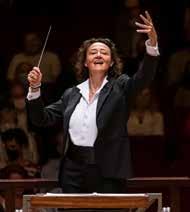
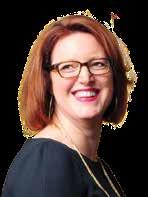
 Jennifer Barlament, Executive Director
Jennifer Barlament, Executive Director
